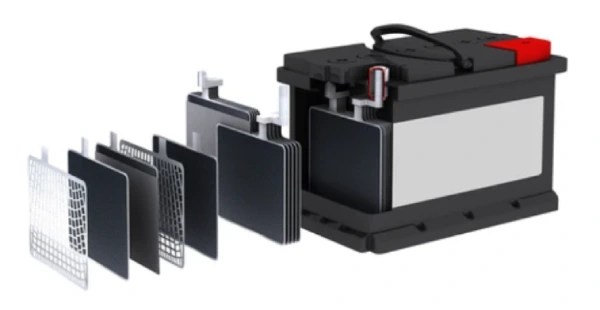Technology is evolving daily. It mainly comprises batteries. These storage batteries can be rechargeable or non-rechargeable. They are power sources for almost every electronic appliance, vehicle, smartphone, toy, and gadget. So, its wide applications enable us to think about it. So, in this article, we will discuss the battery, its composition, how it stores energy, and what its application will be in the future.
Part 1. What is a battery?
The battery is a device that can store energy, i.e., chemical energy, and convert it into electrical energy. It mainly comprises one or more electrochemical cells. These cells have two electrodes, i.e., cathode and anode. Then, these are further separated at some distance by electrolytic solution. So, when you connect the battery to any external circuit, it allows the electrons to flow from a negative plate to the positive plate or electrode. As a result, electricity is produced. These storage batteries are available in different types, such as alkaline, lithium-ion, lead-acid, and nickel-metal hydride batteries.
Part 2. How the battery stores energy
So, once you know about the diverse applications of batteries, it becomes necessary to understand how the battery stores energy. Here, we break the battery process into segments and discuss each in detail.
1. Electrochemical Reaction
The electrochemical reactions are the building blocks of batteries. These reactions mainly consist of two main processes, i.e., oxidation and reduction. These reactions mostly occur at the anode and cathode of the battery. So, let’s discuss these reactions in detail.
Cathode Reaction: A reduction reaction occurs at the cathode (positive electrode). So, let’s take an example of a lithium-ion battery. Here, lithium cobalt oxide gains its lithium-ion and absorbs the electron.
LiCoO2 +Li^+ + e^- ——> Li2(CoO)2
Anode Reaction: Here, the oxidation reaction takes place. So, in a lithium-ion battery example, the lithium atoms with carbon material of anode oxidize and release the electrons. This process is charging the battery. If we talk about discharging, the reaction will be irreversible.
LiC6 —–> Li^+ + e^- + C6
So, this release of electrons and their flow towards the cathode results in the generation of electricity.
2. Reversible Reaction
Reversible reactions in storage batteries will also help you understand how the battery stores energy. The electrons released during the chemical reaction begin to flow through the circuit. So, it ultimately produces electricity. But, when we charge a battery, the electrochemical reactions are reversed. This means that electrical energy is converted back into chemical energy.
The released electrons flow through the external circuit. Thus, they produce an electric current that can power electrical devices connected to the battery.
Part 3. Common battery types & how the storage battery stores energy
As we know, there are multiple batteries available in the market. All of these have their features. So, their way of storing energy is different as well. Here, let’s discuss the standard batteries and how they store energy.
| Battery Type | Energy Storage Mechanism |
|---|---|
| Lead-acid batteries | Chemical energy is stored in lead dioxide and sponge lead plates |
| Lithium-ion batteries | Chemical energy is stored in lithium compounds and graphite |
| Nickel-cadmium batteries | Chemical energy is stored in nickel hydroxide and cadmium |
| Nickel-metal hydride batteries | Chemical energy is stored in metal hydride compounds |
Part 4. Pros and cons of energy storage batteries
| Aspect | Advantages | Disadvantages |
|---|---|---|
| Grid Stability | Helps stabilize the grid during peak demand. Provides backup power during outages. Facilitates integration of renewable energy |
Initial high costs for implementation. Limited energy density compared to fossil fuels. Environmental concerns with certain storage batteries |
| Renewable Integration | Stores excess energy from renewable sources. Helps mitigate the intermittency of renewable sources. Enables shifting of energy demand to off-peak hours. |
Limited energy storage capacity in some technologies. Efficiency losses during charging and discharging. Dependency on rare or hazardous materials for certain types |
| Cost Savings | Reduces electricity costs by peak shaving. Avoid costly peak demand charges. Provides ancillary services to grid operators |
Degradation and aging of storage batteries over time. Limited lifespan of some storage technologies. Land use requirements for large-scale storage batteries installations |
| Energy Independence | Enhances energy security and resilience. Reduces reliance on imported energy sources. Empowers off-grid and remote communities |
Safety concerns related to certain storage batteries. Challenges with recycling and disposal of storage batteries. Regulatory and policy barriers affecting deployment |
Part 5. What factors affect storage battery capacity?
Battery capacity gives us an idea of how much energy a battery can store. So, several factors can contribute to affect the battery capacity. This may include:
- Chemical Composition: The components of the battery, i.e., electrodes and electrolytes, define the energy density and capacity of a battery. So, different batteries have different capacities.
- Physical Size: Generally, capacity and size are directly proportional. This means if the size is bigger, the battery has more energy storage capacity. Moreover, we can say that it can accommodate more active electrolytes and electrodes.
- Temperature: It also affects the battery capacity. Because, in cold conditions, the battery cannot hold or store energy for long. While in hot temperatures, its capacity to store energy increases. But it might decrease its lifespan.
- Charge-Discharge Rate: This parameter has inversely proportional effects on the battery capacity. So, if charge or discharge rates are high, the battery capacity reduces.
- Battery Age: The battery capacity to store the charges over time decreases.
Part 6. Why are storage batteries important?
Energy storage batteries have an important role in modern energy systems. It helps when there is fluctuation or ups and downs in energy. So, when the power is not stabilized, the battery stores it, making it stable, flexible, and even more efficient. Here are some reasons to help us understand why energy storage batteries are important.
1. Grid Stabilization
It is an electrical grid ability. It helps maintain a consistent balance between electric supply and demand. So, a system like storage batteries plays a vital role in grid stabilization. It provides rapid response capabilities. So that it can match fluctuations in suppliers and demand more during periods of high demand or low supply, energy storage systems can discharge stored electricity to the grid. So that it can meet demand and maintain the grid frequency and voltage within the recommended limits, on the other hand, during periods of low demand or excess supply, the energy storage systems can absorb excess electricity and prevent the grid from overloading.
2. Renewable energy Integration
Renewable energy resources have fluctuating outputs based on weather conditions and time of the day. They give different values at different times. So, energy storage batteries help them better integrate energy into the grid. It stores excess energy generated during high renewable energy production periods and releases it during low production or high demand. So, it is smoothing the fluctuations in renewable energy outputs. Moreover, it provides a more reliable and consistent electricity supply. It also reduces the need for backup of fossil fuels based on power generation. Additionally, it reduces the need to support transitions to a cleaner energy mix.
3. Peak Shaving
It includes reducing or flattening the peaks in electric demands. So, it avoids or minimizes the expensive pre-demand charges. The energy storage system helps with peak shaving. It stores electricity during off-periods when the demands and prices are low. Then, it is supplied during peak demand periods when electricity prices are high. So, strategically, it manages the time spent on energy consumption and storage. Moreover, the energy storage system can help businesses, utilities, and consumers reduce electricity costs. So, they can improve their overall efficiency.
4. Energy Arbitrage
It includes buying electricity when the prices are low and then selling it back to the grid. It also means using it when prices are high to maximize the cost savings. So, energy storage systems help you store electricity when the prices are low. By capitalizing on fluctuations in electricity prices, the energy storage system can help you to optimize energy consumption and reduce electricity bills.
5. Backup power
It also refers to the ability to provide electricity during grid outages or emergencies. So, the energy storage system, particularly storage batteries, can serve as a backup power source for critical infrastructures, businesses, and residential properties. It also gives an uninterrupted power supply during outages. Moreover, it improves resilience and reliability for essential services and operations.
6. Support for electric vehicle charging.
The energy storage system can support electrical vehicle (EV) charging infrastructure. It provides fasting charging capabilities. Moreover, it manages demand spikes and optimizes the charging schedules. So, electricity can be stored from the grid during peak hours and discharged to the Ev’s during demand. You can say that energy storage systems can help utilities and owners avoid strains on the grid. Moreover, it supports the widespread adoption of electric vehicles in this system. It also reduces greenhouse gases that can lead to the improvement of air quality.
Part 7. What are the long-term energy storage challenges?
There are different long-term challenges present. These may include.
- Degradation: Overtime battery’s ability to hold the charges efficiently reduces. It is because of the chemical reactions within the cells.
- Limited lifespan: Batteries have an average lifespan of 3 to 5 years. The number of charge-discharge cycles typically determines it.
- Efficiency loss: During the charging and discharging, batteries lose energy as heat, which rescues the overall efficiency of the batteries.
- Dependency on materials: Some batteries rely on rare or hazardous materials like lead-acid batteries. So, they have some environmental impacts.
- Recycling and disposal: Storage batteries need proper recycling and disposal to reduce the environmental impact.
- Safety concerns: Batteries may have safety risks, such as overheating, fire hazards, and exposure. So, it is necessary to handle and manage them carefully.
Part 8. Conclusion
In conclusion, how does a battery store energy? A battery stores energy through different chemical processes. This involves electrodes and electrolyte solutions. So, when you connect a device with some external circuit, the electrons flow from the negative plate to the positive plate. It results in the generation of electricity through the oxidation-reduction reactions.
If we talk about the charging process, it is a reversible process. It converts the electrical energy back into chemical energy. Different factors affect the battery’s capacity. Despite its advantages, it also has some disadvantages, such as high initial costs and environmental concerns. However, overall, storage batteries are an essential component of modern technology.
Related Tags:
More Articles

Where to Find the Right 18650 Battery Wholesale?
Discover how to choose a reliable 18650 battery wholesale supplier, compare prices, ensure safety, and avoid common buying mistakes.
18650 Battery Short Circuit: Risks and Safety Tips
Discover what happens during a 18650 battery short circuit, warning signs, and how to avoid fire, damage, and hazardous failures in your devices.
LiPo Battery Discharge Rate Guide & Calculation Tips
Understand LiPo battery discharge rates, C-ratings, and how to calculate max current. Essential guide for RC, drones, and electronics users.
High‑Capacity 3S LiPo Batteries: 5000 mAh vs. 10000 mAh
Compare 3S LiPo 5000mAh vs 10000mAh batteries by weight, power, and use. Find the best fit for your drone, RC car, or boat setup.
Top 5 Applications for Small 3S LiPo Batteries
Small 3S LiPo batteries power drones, RC gear, wearables, and robotics with high energy and low weight. Making them ideal for compact electronics projects.





